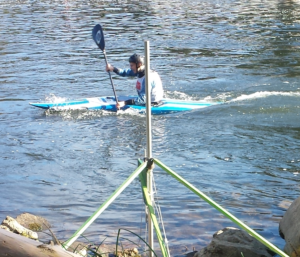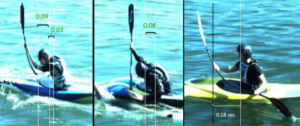By Gerrit van Dalfsen (Tijdteam.nl) Canoe/ kayak races have individual starts and finishes. Typical run times between start and finish are 80 to 180 seconds. The runtimes of top-athletes are less than 1 second apart. Photo beam are commonly used in canoe slalom, but are they good enough for accurate timing?
The International Canoe Federation (ICF) requires for canoe/kayak slalom races a timing accuracy of better than 1/100 sec. Runtimes should be presented with an precision of 1/100 sec.

Using photo beam in canoe slalom
The timing accuracy for runtimes, when using manual pushbuttons at start and finish can approach 0.3 sec. When a photo beam is used to record start and finishes, the runtime accuracy can be improved, but there are pitfalls.
Photo beam
Photobeams consist of a photocell transmitter and a photocell receiver. The photocell transmitter sends constantly a lightbeam to the photocell receiver. As long as the photocell receiver receives the lightbeam, the receiver does not give a signal. When the receiver does not receive a lightbeam it gives a signal. Not receiving a lightbeam may be due to a misalignment of the transmitter and receiver, or because a kayaker is interrupting the lightbeam. The receiver signal at an interruption of the lightbeam is used to trigger a timerclock to set a timestamp.
Photobeams to be used for timing canoe/ kayak slalom races must meet specific requirements. To span the width of a slalom course, the beams must be more than 10 meters wide. In some cases a beam width or more than 40 meters is required. Photocell transmitters and receivers are to be placed on the side walls of a slalom course, which are in many cases river banks with plants. You need some dedicated tripots to place the photocells in the river bank, and then have the possibility to align the photocells and put them on the right height above the water .
The photocells are out in the open, and must be watertight. When positioning the photocell it does happen that the photocell drops into the water. The photocell should stand that. Further, when insects flies though the photo beams, or when it rains, the photo beams should not fire from those minor interruptions.
In the electronics shop you can buy a wide variety of photo beams. But most of these photo beams do not match the requirements stated above. Even photo beams sold by timing equipment companies do not match these requirements.
That is why the Gennepermolen timing team (Netherlands) developed a set of photo beams that do match these requirements.
Photo beam accuracy
Photo beams are expected to meet the accuracy requirements of the ICF. Theoretically that is the case. But practically there are issues. It has been observed that it can be the paddle, the arm of the trunk of the paddler that interrupts the photo beam and triggers the timestamp. On rough water it can even be the bow of the kayak that interrupts the photo beam.

Accuracy of Photofinish camera in slalom
Measurements with a timing camera shows that interrupting the photo beam with the paddle or with the trunk, can make a timing difference of up to 0.2 sec. So two paddlers which have theoretically the same runtime, can get results, when measured with photo beams, that differ up to 0.2 sec. As a consequence the runtime accuracy of slalom races when measured with photo beams is not better than 0.2 sec.
This inaccuracy of the photo beam measuring method is ignored at international competitions and is accepted as being part of the game. As the ICF rules require the runtimes being shown with a precision of 1/100 sec, the rankings based on this precision for runtimes that are less then 0.2 sec apart can be sheer lottery.

